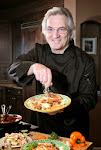When I titled this blog post "Real Mexican Food," I was actually referring to these countryside dishes that Chef Rick Bayless and Chef Lorena Garcia have popularized.
It also brings to mind a trip I made to Mexico more than 20 years ago. My brother and I went to Mazatlan for a few days and we met up with a few other American guys and several Canadians. But five or six of us stuck together -- ordering buckets of beers on the beach and otherwise having a rousing good time. We soon learned that Mazatlan was also a popular vacation spot for Mexicans of means and we met up with a group of young women who seemed to get a kick out of the rousing good time the five of us were having.
They spoke almost no English and I was the only one who could speak Spanish with any competency, so I became the official translator. Since this is a food blog, we'll talk about the food aspect of this story, rather than the -- er, um -- social component.
The girls told me they were going into the "real" Mazatlan for dinner -- and would we like to join them? My first question was, "What do you mean "the real Mazatlan?" As it turns out, there are actually two Mazatlans. One for us tourists and one for the true residents of Mazatlan. It was a fairly short taxi ride away, but what an incredible difference in the atmosphere, the commerce, and especially the food.
In the resort Mazatlan, the food offerings were what Americans and Canadians expected of Mexican food: tacos, burritos, chalupas, salsa and chips, nachos -- and beer. Lots and lots of beer. And shots of tequila with mariachi bands at places like Senor Frog's and other such tourist havens.
But in the real Mazatlan, we found elegant restaurants with expertly prepared food -- great seafood and perfectly grilled meats and vegetables. There was hardly a tortilla in sight. The guacamole was relish-like rather than a smooth green paste. The ingredients in the salsas showed that the kitchen staff had knife skills and cared about the proportion of vegetables to spices, etc.
That's when I first learned that there is Mexican cuisine in addition to Mexican food. Most of what passes for Mexican food in this country is actually "Tex-Mex," created in Texas and because of the state's proximity to Mexico, the ingredients are largely those found in true Mexican food.
That's what this week's recipe is about: Real Mexican Food. Chilaquiles -- also known as Salsa-Simmered Tortilla Chips -- it's a true country dish from the farms of Mexico. It often will have shredded meats, either chicken, pork or beef, whatever may be left over from last night's dinner. And sometimes it is even made lasagna style -- layering the fried tortilla chips in between layers of the meat and the roasted vegetables that make up the salsa.
Here's this week's video and the recipe:
6 Roma (plum) tomatoes
2 garlic cloves
1 jalapeño, stemmed, halved and seeded
1 small white onion, quartered
2 Tbsp vegetable oil, plus more for deep-frying
4 canned chipotle chiles in adobo
4 Tbsp cilantro, roughly chopped
1 1/2 Tbsp sesame seeds, toasted
1/4 tsp dried oregano (Mexican if you have it)
10 6-inch corn tortillas, stacked and cut into 1/2-inch squares
salt to taste
6 oz chorizo sausage, removed from casing and chopped
1/4 cup sour cream (or crema)
2 oz Cotija cheese (or Feta)
4 radishes, thinly sliced, for garnish
Heat the oven using the broiler. In a bowl, toss the tomatoes, garlic, jalapeño and onions with 2 Tbsp of vegetable oil. Transfer the vegetables to a foil-lined baking sheet and broil, turning occasionally until the tomato skins blister and begin to blacken.
Transfer roasted vegetables to the bowl of a food processor, add the chipotles with adobo, along with 2 Tbsp cilantro, sesame seeds, oregano and 1/4 cup of water and puree until smooth. Set the sauce aside.
Pour vegetable oil into a skillet to a depth of 1 inch. Heat until your thermometer (candy or deep-fry) reaches 350. Fry the tortillas squares until golden brown and crisp and drain on paper towels. Season with salt.
Heat another large skillet over medium high heat and add the chorizo. Cook, breaking up the pieces with a wooden spoon until cooked through and browned. Add the pureed sauce to the skillet and stir to combine. Season with salt. Bring to a simmer and add the fried tortilla chips, stirring to combine.
Cook just long enough until the chips begin to soften slightly, then transfer to a serving plate and garnish with sour cream, Cotija and sliced radishes.




